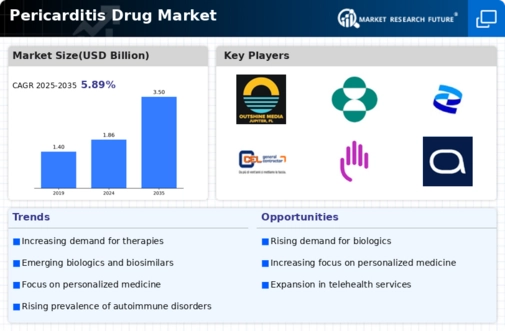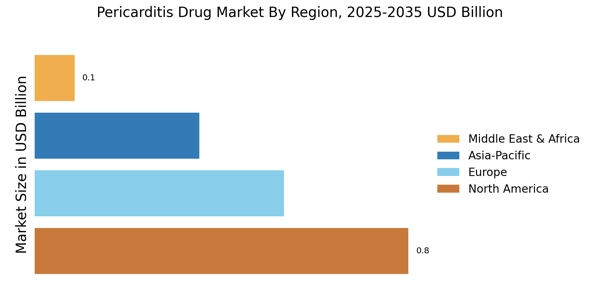Advancements in Drug Development
Advancements in drug development technologies are significantly influencing the Pericarditis Drug Market. The introduction of novel therapeutic agents, including biologics and small molecules, has expanded treatment options for patients suffering from pericarditis. Recent innovations in drug formulation and delivery systems have enhanced the efficacy and safety profiles of these medications. For instance, the development of targeted therapies that specifically address the underlying causes of pericarditis has shown promise in clinical trials. This trend is expected to continue, with the market projected to grow at a compound annual growth rate of approximately 6.5% over the next five years. As a result, pharmaceutical companies are increasingly focusing on research initiatives aimed at discovering new drugs, which is likely to bolster the Pericarditis Drug Market.
Rising Incidence of Pericarditis
The increasing incidence of pericarditis is a notable driver for the Pericarditis Drug Market. Recent data indicates that the prevalence of pericarditis has been on the rise, with estimates suggesting that it affects approximately 27 per 100,000 individuals annually. This growing patient population necessitates the development and availability of effective therapeutic options. As healthcare providers become more aware of the condition, the demand for specialized treatments is likely to increase. Furthermore, the rising incidence may be attributed to various factors, including autoimmune diseases and infections, which are known to contribute to pericarditis. Consequently, pharmaceutical companies are motivated to invest in research and development to address this unmet medical need, thereby propelling the Pericarditis Drug Market forward.
Increased Awareness and Education
Increased awareness and education regarding pericarditis among healthcare professionals and patients are driving the Pericarditis Drug Market. As more information becomes available about the symptoms, causes, and treatment options for pericarditis, healthcare providers are better equipped to diagnose and manage the condition. Educational initiatives, including workshops and seminars, are being implemented to enhance understanding of pericarditis, leading to earlier diagnosis and treatment. This heightened awareness is likely to result in an increase in patient referrals to specialists, thereby boosting the demand for effective medications. Furthermore, patient advocacy groups are playing a crucial role in disseminating information, which may contribute to a growing patient population seeking treatment. Consequently, the Pericarditis Drug Market is expected to benefit from this trend.
Regulatory Support for New Therapies
Regulatory support for the approval of new therapies is a critical driver for the Pericarditis Drug Market. Regulatory agencies are increasingly recognizing the need for innovative treatments to address unmet medical needs in pericarditis management. Initiatives such as expedited review processes and orphan drug designations are encouraging pharmaceutical companies to invest in the development of new therapies. For instance, recent approvals of novel medications for inflammatory conditions have set a precedent for the potential approval of pericarditis treatments. This supportive regulatory environment is likely to accelerate the entry of new drugs into the market, thereby expanding the available treatment options for patients. As a result, the Pericarditis Drug Market is poised for growth as new therapies become accessible.
Growing Investment in Healthcare Research
Growing investment in healthcare research is a significant driver for the Pericarditis Drug Market. Increased funding from both public and private sectors is facilitating research initiatives aimed at understanding the pathophysiology of pericarditis and developing effective treatments. This trend is evident in the rising number of clinical trials focused on pericarditis therapies, which have increased by over 30% in recent years. Such investments are crucial for fostering innovation and advancing the development of new drugs. Additionally, collaborations between academic institutions and pharmaceutical companies are becoming more common, further enhancing research capabilities. This influx of resources is likely to lead to breakthroughs in treatment options, thereby positively impacting the Pericarditis Drug Market.


















Leave a Comment